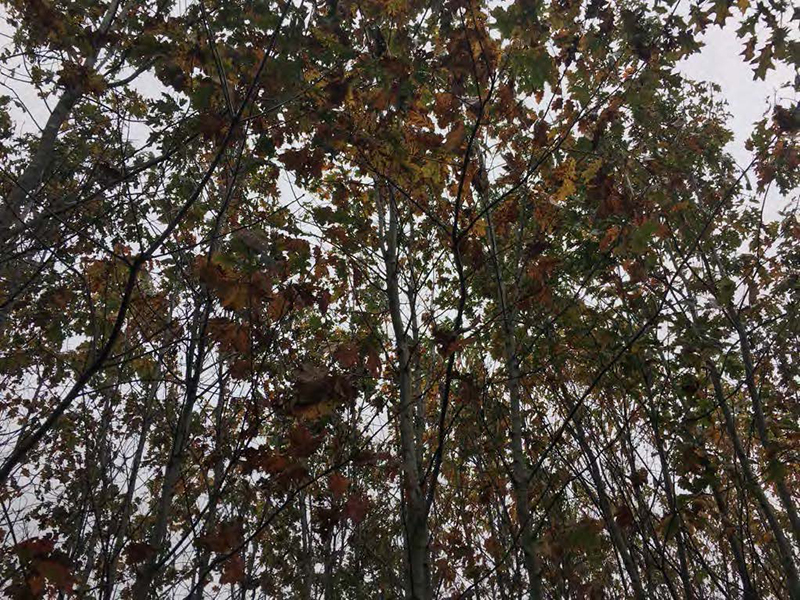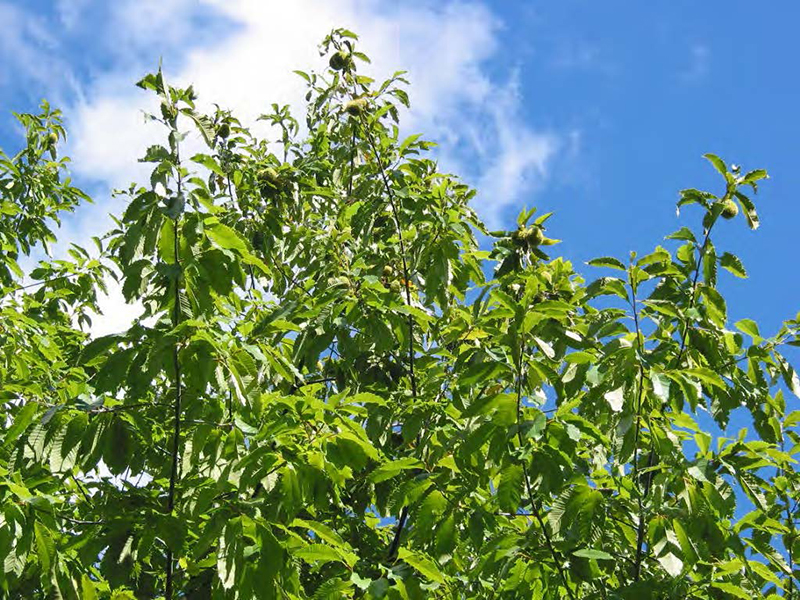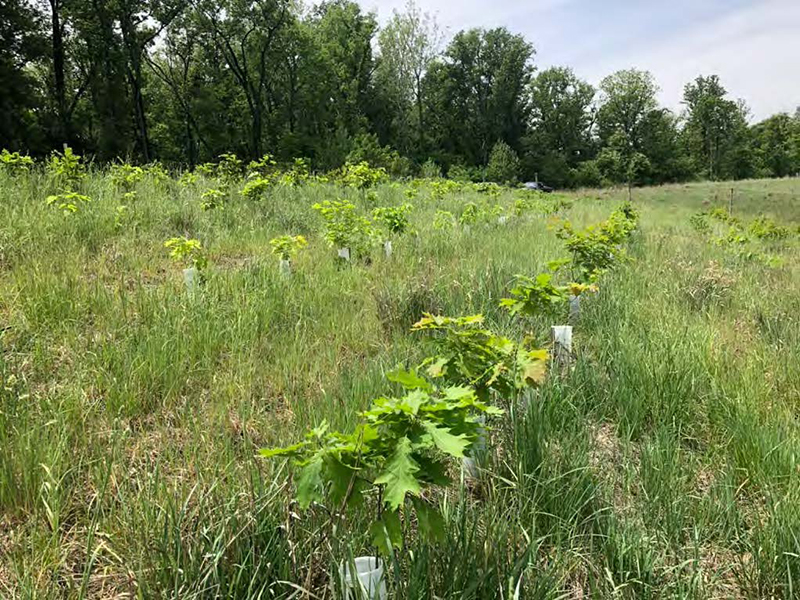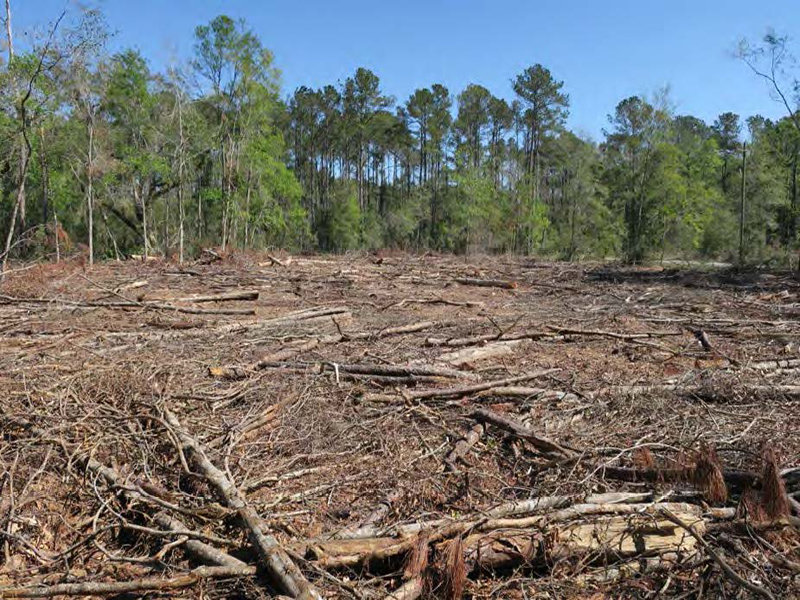Research
Our research emphasizes the reforestation and restoration of hardwood species, which have been studied worldwide much less than conifers. We address two major themes: 1) seedling quality and planting, and 2) restoration of threatened forest tree species. This research is globally important to help meet ambitious new targets for tree planting around the world, while also addressing threats to native forest tree species from global change including introduction of damaging exotic pests.
We carry out a wide variety of research projects focused on cultural treatments during nursery propagation, site preparation and planting techniques, ecophysiology of plantation establishment in response to abiotic and biotic stresses, and interactions between genetics and silviculture to promote deployment of pest-resistant trees. This research requires conceptual integration of principles from many disciplines (i.e., soils, mineral nutrition, plant physiology, remote sensing, ecology, and genetics), and we collaborate with a wide diversity of international scientists.
Our program is closely integrated within the Hardwood Tree Improvement and Regeneration Center (HTIRC) at Purdue University, a collaborative research, development, and technology transfer effort for hardwood stewardship in direct partnership between Purdue and the USDA Forest Service. The HTIRC addresses productivity of hardwood trees native to the Central US, including walnut and oaks, while also working to overcome forest health threats to native species such as American chestnut, butternut, and ash. The HTIRC co-initiated the only forestry-based National Science Foundation (NSF) Industry/University Cooperative Research Center(I/UCRC), which has since expanded to include seven universities.
The HTIRC has also expanded its scope to address parallel issues in Pacific Island hardwood tree species, by forming the Tropical Hardwood Tree Improvement and Regeneration Center (TropHTIRC). The TropHTIRC works with partners including the University of Hawaiʻi at Mānoa and the USDA Forest Service Institute of Pacific Islands Forestry to improve restoration and pest resistance in tropical hardwoods native to Hawaiʻi, including koa, ʻiliahi (sandalwood), and ʻōhiʻa.

Many of our lab’s ongoing research projects are focused on native forest tree species of the Hawaiian Islands and are described at our TropHTIRC website.
In addition, some of our current research projects with temperate hardwood forest tree species include:
Past Projects
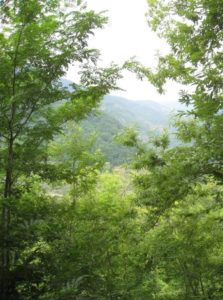 Eastern deciduous forests represent an important proportion of the US forest carbon (C) stores, and imminent, largely anthropogenic forest changes present unique challenges and opportunities for this important C pool. A legacy of direct and indirect human impacts have altered tree species composition of eastern deciduous forests at regional scales, and this trend is likely to continue as new exotic pests spread throughout the forest. Such changes may affect short-term C biogeochemistry, long-term C storage capacity, and the resilience of these forests to new pests and climate change. However, the imminent reintroduction of blight- resistant American chestnut (Castanea dentata) has potential to increase C storage and ameliorate declines in other tree genera because of its relative shade tolerance, rapid growth rate, large size, longevity, and decay resistance. We have initiated a study to forecast landscape scale C storage in eastern forests under a set of plausible alternative futures that include expected and potential declines in existing tree species due to exotic pests, forest restoration activities targeting chestnut and oaks, and the direct and indirect effects of climate change. We will generate forecasts using a landscape disturbance and succession model (LANDIS II) with input parameters informed by targeted field studies, our recent remote sensing research, and an ecosystem physiology model (PnET-II). A factorial simulation experiment will test the effect of five factors (prescribed fire, climate change, existing insect pests, potential insect pests, and chestnut restoration) on C storage in eastern forests.
Eastern deciduous forests represent an important proportion of the US forest carbon (C) stores, and imminent, largely anthropogenic forest changes present unique challenges and opportunities for this important C pool. A legacy of direct and indirect human impacts have altered tree species composition of eastern deciduous forests at regional scales, and this trend is likely to continue as new exotic pests spread throughout the forest. Such changes may affect short-term C biogeochemistry, long-term C storage capacity, and the resilience of these forests to new pests and climate change. However, the imminent reintroduction of blight- resistant American chestnut (Castanea dentata) has potential to increase C storage and ameliorate declines in other tree genera because of its relative shade tolerance, rapid growth rate, large size, longevity, and decay resistance. We have initiated a study to forecast landscape scale C storage in eastern forests under a set of plausible alternative futures that include expected and potential declines in existing tree species due to exotic pests, forest restoration activities targeting chestnut and oaks, and the direct and indirect effects of climate change. We will generate forecasts using a landscape disturbance and succession model (LANDIS II) with input parameters informed by targeted field studies, our recent remote sensing research, and an ecosystem physiology model (PnET-II). A factorial simulation experiment will test the effect of five factors (prescribed fire, climate change, existing insect pests, potential insect pests, and chestnut restoration) on C storage in eastern forests.
(Funding: USDA NIFA, Climate Change: Carbon Cycle)
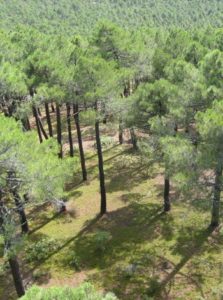 Six native populations of pines (Pinus spp.) occur in the Iberian Peninsula of southwestern Europe: P. halepensis, P. pinaster, P. pinea, P. nigra, P. sylvestris and P. uncinata. These species form large forests that provide important ecosystem services and have a high socioeconomic and cultural value. Native populations of Iberian pines show an important spatial segregation that correlates with rainfall, low winter temperature and soil properties. Forestry and ecological research has made a considerable effort to identify functional differences among provenances in Iberian Pinus spp. However, in contrast, we have not yet developed a solid ecophysiological basis, experimentally-sustained, for explaining the distribution pattern of Iberian pines. Thus, the aim of the project is to study the ecophysiological strategies of Iberian pines at juvenile stages to drought, low temperature and soil nutrient availability through a series of laboratory/nursery trials and a field experiment in the Sierra Nevada (Granada, Spain).
Six native populations of pines (Pinus spp.) occur in the Iberian Peninsula of southwestern Europe: P. halepensis, P. pinaster, P. pinea, P. nigra, P. sylvestris and P. uncinata. These species form large forests that provide important ecosystem services and have a high socioeconomic and cultural value. Native populations of Iberian pines show an important spatial segregation that correlates with rainfall, low winter temperature and soil properties. Forestry and ecological research has made a considerable effort to identify functional differences among provenances in Iberian Pinus spp. However, in contrast, we have not yet developed a solid ecophysiological basis, experimentally-sustained, for explaining the distribution pattern of Iberian pines. Thus, the aim of the project is to study the ecophysiological strategies of Iberian pines at juvenile stages to drought, low temperature and soil nutrient availability through a series of laboratory/nursery trials and a field experiment in the Sierra Nevada (Granada, Spain).
(Funding: Spanish Ministry of Science and Innovation)
 Only a small proportion of fertilizer nitrogen (N) applied to forest plantations is taken up by crop trees. Limited past research suggests only 10 to 25% of applied fertilizer N enters the crop trees with the remainder tied up in other ecosystem components or lost. A better understanding of the fate of applied N fertilizer in forests is needed to improve economic returns from investment in fertilization and reduce negative environmental impacts. We have established a series of trials using nitrogen-15 to compare N uptake following fertilization with four conventional and enhanced efficiency N fertilizers (urea, coated urea, urea+NBPT, controlled release N) in three of the most important commercial tree species in the U.S. [loblolly pine (Pinus taeda), Douglas-fir (Pseudotsuga menziesii), and black walnut (Juglans nigra)] across multiple stands managed using modern silvicultural practices. This research will increase our knowledge of the fate of applied N and the fundamental processes controlling N transformations in forest ecosystems. This information will be of great value because it will lead to improved forest productivity and more efficient use of high cost N fertilizer. It will also be valuable to the broader scientific community interested in developing an improved understanding of fundamental ecosystem processes affecting N dynamics in forests.
Only a small proportion of fertilizer nitrogen (N) applied to forest plantations is taken up by crop trees. Limited past research suggests only 10 to 25% of applied fertilizer N enters the crop trees with the remainder tied up in other ecosystem components or lost. A better understanding of the fate of applied N fertilizer in forests is needed to improve economic returns from investment in fertilization and reduce negative environmental impacts. We have established a series of trials using nitrogen-15 to compare N uptake following fertilization with four conventional and enhanced efficiency N fertilizers (urea, coated urea, urea+NBPT, controlled release N) in three of the most important commercial tree species in the U.S. [loblolly pine (Pinus taeda), Douglas-fir (Pseudotsuga menziesii), and black walnut (Juglans nigra)] across multiple stands managed using modern silvicultural practices. This research will increase our knowledge of the fate of applied N and the fundamental processes controlling N transformations in forest ecosystems. This information will be of great value because it will lead to improved forest productivity and more efficient use of high cost N fertilizer. It will also be valuable to the broader scientific community interested in developing an improved understanding of fundamental ecosystem processes affecting N dynamics in forests.
(Funding: National Science Foundation)
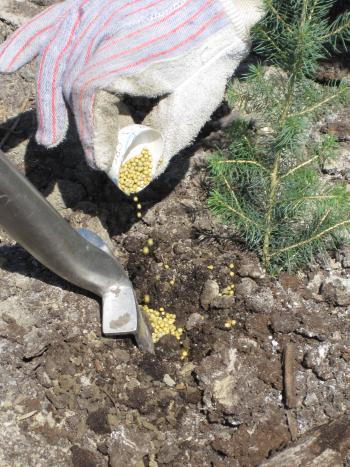 Prompt and efficient reclamation of mined lands is important to help restore these heavily impacted lands and promote ecosystem function. Survival and growth of planted tree seedlings on these sites are limited by water and nutrient availability associated with vegetative competition. Field fertilization offers a means to help alleviate these early stresses, but broadcast fertilization with traditional agronomic fertilizers releases nutrients immediately upon application with generally low rates of fertilizer recovery. In contrast, controlled-release fertilizer (CRF), designed to release nutrients slowly over longer time frames for plant uptake, offers an alternative that may provide plants with enhanced mineral nutrition for extended periods. This may provide a more consistent and sustained nutrient supply that better matches plant demand, thereby improving overall fertilizer use efficiency and minimizing nutrient leaching. Thus, we initiated a research program in the oil sands region of northern Alberta, Canada to examine various CRF application types and rates in comparison to immediately-available fertilizer treatments for reclamation of quaking aspen (Populus tremuloides) and white spruce (Picea glauca). In addition, we are determining the fate of applied nitrogen from different fertilizer treatments through use of the rare stable isotope, nitrogen-15, which allows for detection of fertilizer-applied N in seedlings, competing vegetation, and soils. This research is needed to identify cost effective fertilizer application rates that optimize survival and growth of tree seedlings to facilitate restoration, while simultaneously minimizing environmental contamination.
Prompt and efficient reclamation of mined lands is important to help restore these heavily impacted lands and promote ecosystem function. Survival and growth of planted tree seedlings on these sites are limited by water and nutrient availability associated with vegetative competition. Field fertilization offers a means to help alleviate these early stresses, but broadcast fertilization with traditional agronomic fertilizers releases nutrients immediately upon application with generally low rates of fertilizer recovery. In contrast, controlled-release fertilizer (CRF), designed to release nutrients slowly over longer time frames for plant uptake, offers an alternative that may provide plants with enhanced mineral nutrition for extended periods. This may provide a more consistent and sustained nutrient supply that better matches plant demand, thereby improving overall fertilizer use efficiency and minimizing nutrient leaching. Thus, we initiated a research program in the oil sands region of northern Alberta, Canada to examine various CRF application types and rates in comparison to immediately-available fertilizer treatments for reclamation of quaking aspen (Populus tremuloides) and white spruce (Picea glauca). In addition, we are determining the fate of applied nitrogen from different fertilizer treatments through use of the rare stable isotope, nitrogen-15, which allows for detection of fertilizer-applied N in seedlings, competing vegetation, and soils. This research is needed to identify cost effective fertilizer application rates that optimize survival and growth of tree seedlings to facilitate restoration, while simultaneously minimizing environmental contamination.
(Funding: Suncor Energy, Inc.)
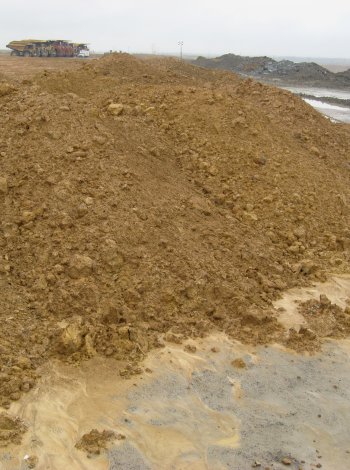 On a Peabody Energy mine reclamation site in southwestern Indiana, we are examining effects of loose grading during soil preparation on American chestnut (Castanea dentata) and oak (Quercus spp.) seedling survival and growth, physiology, shoot and root biomass allocation, and soil characteristics. Our study objectives are to
On a Peabody Energy mine reclamation site in southwestern Indiana, we are examining effects of loose grading during soil preparation on American chestnut (Castanea dentata) and oak (Quercus spp.) seedling survival and growth, physiology, shoot and root biomass allocation, and soil characteristics. Our study objectives are to
i) evaluate influence of loosely dumped soil replacement in association with the Forest Reclamation Approach on selected chemical (e.g., nutrient availability, pH) and physical (e.g., compaction/bulk density, water holding capacity and infiltration rates) properties of the rooting media, and surface soil erosion,
ii) determine the effects of varying soil replacement techniques on survival, growth, rooting strategies, and nutrient uptake of planted seedlings,
iii) explore physiological and nutritional mechanisms that explain improved performance under imposed treatments,
iv) determine suitability of American chestnut and selected oak species for restoration of reclaimed mine sites in the Midwestern Coal Region, and
v) assess feasibility of using hand planting for mine reclamation in this region.
(Funding: Department of Interior, Office of Surface Mining)
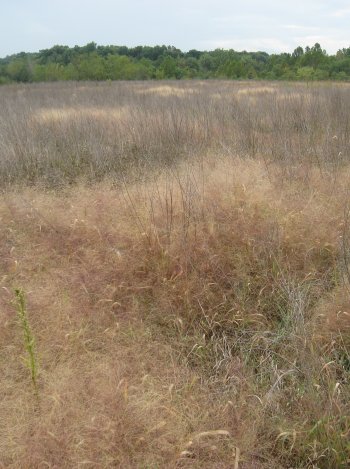 Mine reclamation sites are typically characterized by poor rooting mediums and competitive ground cover species, both of which serve to impede establishment, survival, and productivity of tree seedlings. Chemical site preparation and release treatments using herbicide are often used to promote establishment of native forest tree species, yet the potential phytotoxicity to desired crop trees and environmental impacts are not clearly understood. We are examining metsulfuron methyl application rates and timing and their interactions on survival, growth, and phytotoxicity of American chestnut (Castanea dentata) and oaks (Quercus spp.) on a reclaimed mine site in southwestern Indiana. Additionally, we are studying the efficacy of treatments on competing vegetation and herbicide persistence in the soil. These results should help to devise a practical management approach that promotes mine reclamation, while minimizing pesticide use.
Mine reclamation sites are typically characterized by poor rooting mediums and competitive ground cover species, both of which serve to impede establishment, survival, and productivity of tree seedlings. Chemical site preparation and release treatments using herbicide are often used to promote establishment of native forest tree species, yet the potential phytotoxicity to desired crop trees and environmental impacts are not clearly understood. We are examining metsulfuron methyl application rates and timing and their interactions on survival, growth, and phytotoxicity of American chestnut (Castanea dentata) and oaks (Quercus spp.) on a reclaimed mine site in southwestern Indiana. Additionally, we are studying the efficacy of treatments on competing vegetation and herbicide persistence in the soil. These results should help to devise a practical management approach that promotes mine reclamation, while minimizing pesticide use.
(Funding: Indiana Department of Natural Resources, Division of Reclamation)
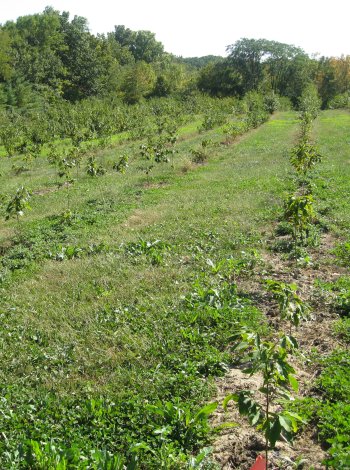 Blight-resistant backcross hybrid American chestnut (Castanea dentata) seedlings will be available for restoration efforts in the near future and mine reclamation sites may be important targets for chestnut plantings. However, these reclaimed mine sites often have harsh environmental conditions, such as poorly drained, compacted soils, as well as extreme (high or low) pH conditions. The soil borne oomycete pathogen, Phytophthora cinnamomi, will also pose limitations to the successful reintroduction of American chestnut particularly under the compacted, wet soils that may characterize mine reclamation sites. Thus, this project is designed to examine root necrosis and physiological responses of American chestnut seedlings to Phytophthora cinnamomi under varying pH. This information should contribute toward providing scientifically supported prescriptions for American chestnut restoration on site types where these factors threaten early establishment.
Blight-resistant backcross hybrid American chestnut (Castanea dentata) seedlings will be available for restoration efforts in the near future and mine reclamation sites may be important targets for chestnut plantings. However, these reclaimed mine sites often have harsh environmental conditions, such as poorly drained, compacted soils, as well as extreme (high or low) pH conditions. The soil borne oomycete pathogen, Phytophthora cinnamomi, will also pose limitations to the successful reintroduction of American chestnut particularly under the compacted, wet soils that may characterize mine reclamation sites. Thus, this project is designed to examine root necrosis and physiological responses of American chestnut seedlings to Phytophthora cinnamomi under varying pH. This information should contribute toward providing scientifically supported prescriptions for American chestnut restoration on site types where these factors threaten early establishment.
(Funding: The American Chestnut Foundation)
 Forest restoration programs on the island of Hawaii commonly involve planting of nursery-grown native forest tree seedlings to help rehabilitate grazed areas that were formerly native forest. These nurseries generally rely upon overhead irrigation to produce seedlings, which results in poor water use efficiency because of the broad foliar canopies that characterize many of these native hardwoods. Fertilizer nutrients are also leached from these overhead irrigation systems, which may cause environmental contamination. We are examining use of subirrigation, whereby plants are watered from beneath container cells, as an alternative to traditional overhead irrigation systems. Using subirrigation, irrigation water is maintained within a closed system in which water is pumped from a reservoir tank to an application tank and saturates media in plant container cells via capillary rise. Because the system is closed, no leaching of water or fertilizer nutrients occurs and plant quality may be improved due to better uniformity of irrigation. We have established subirrigation nursery demonstrations at several native plant nurseries on the Island of Hawaii for propagation of three native species including koa (Acacia koa), ohia (Metosiderous polymorpha), and mamane (Sophora chrysophylla). Seedlings were subsequently outplanted into high-elevation forest restoration sites. These trials have helped to confirm that subirrigation produces seedlings of equal or better quality to overhead irrigation, while simultaneously reducing environmental impacts.
Forest restoration programs on the island of Hawaii commonly involve planting of nursery-grown native forest tree seedlings to help rehabilitate grazed areas that were formerly native forest. These nurseries generally rely upon overhead irrigation to produce seedlings, which results in poor water use efficiency because of the broad foliar canopies that characterize many of these native hardwoods. Fertilizer nutrients are also leached from these overhead irrigation systems, which may cause environmental contamination. We are examining use of subirrigation, whereby plants are watered from beneath container cells, as an alternative to traditional overhead irrigation systems. Using subirrigation, irrigation water is maintained within a closed system in which water is pumped from a reservoir tank to an application tank and saturates media in plant container cells via capillary rise. Because the system is closed, no leaching of water or fertilizer nutrients occurs and plant quality may be improved due to better uniformity of irrigation. We have established subirrigation nursery demonstrations at several native plant nurseries on the Island of Hawaii for propagation of three native species including koa (Acacia koa), ohia (Metosiderous polymorpha), and mamane (Sophora chrysophylla). Seedlings were subsequently outplanted into high-elevation forest restoration sites. These trials have helped to confirm that subirrigation produces seedlings of equal or better quality to overhead irrigation, while simultaneously reducing environmental impacts.
(Funding: USDA National Resources Conservation Service)



